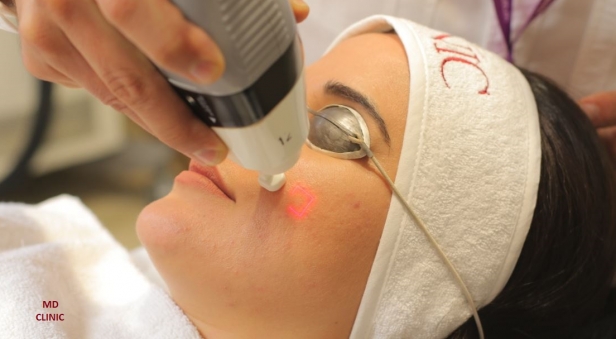
Fractional laser treatment
Fractional laser treatment is a non-invasive treatment that uses a device to deliver a laser beam divided into thousands of microscopic treatment zones that target a fraction of the skin at a time. This is analogous to a photographic image being enhanced or altered pixel by pixel.
Fractional laser treatment has bridged the gap between the ablative and non-ablative laser techniques used to treat sun-damaged and aging skin. Whilst ablative laser treatments work mainly on the epidermis (surface skin cells) and non-ablative treatments work solely on dermal collagen (mid-layer of skin) only, fractional laser treatment works at both the epidermal and dermal layers of the skin.
What is it used to treat?
Fractional laser treatment is used for the treatment of facial lines and wrinkles (rhytides) and skin pigmentation associated with photoaging, surgical and acne scarring, and chloasma.
Fractional laser treatment can be used on any part of the body, but is particularly useful on the neck, chest and hands when compared to traditional ablative modalities.
Fractional laser treatment may also be of benefit for poikiloderma of Civatte and stretch marks.
How does it work?
To understand how fractional laser treatment works a basic understanding of skin structure is required. Briefly skin consists of 3 layers, the epidermis (uppermost layer), dermis (mid-lay) and subcutis (lower fat layer). The epidermis contains pigment-producing cells called melanocytes, which are responsible for skin colouring. The dermis is made up of collagen and elastin fibres that provide skin with strength, toughness, elasticity and pliability (click here for detailed information on skin structure).
As the body ages, the appearance and characteristics of the skin alter. The epidermis becomes thinner so blemishes become more visible, and collagen in the dermis is gradually lost which contributes to the formation of facial lines, sagging skin and wrinkles.
Fractional laser treatment works by targeting both the epidermis and dermis. It does this by delivering a laser beam that is divided into thousands of tiny but deep columns of treatment into the skin. These are called microthermal treatment zones (MTZs). Within each MTZ old epidermal pigmented cells are expelled and penetration of collagen in the dermis causes a reaction that leads to collagen remodelling and new collagen formation. By using MTZs, the laser targets and treats intensively within the zone whilst surrounding healthy tissue remain intact and unaffected. This fractional treatment results in a faster healing process than if all tissue in the treatment area was exposed to the laser.
Pre-treatment assessment/preparation
* Define problem areas and tailor a treatment pattern to target the areas for correction.
* Take pre-treatment photographs.
* Patient needs to remove all jewellery and makeup. Wash face with soap and water prior to treatment.
* An anaesthetic cream is applied to the treatment area. It takes about 45-60 minutes for the anaesthetic to take full effect.
Application
* The gliding gel acts as the contact lubricant for the robotic hand piece that glides across the skins surface.
* Treatment time will depend on the areas being treated, but a full face will take around 20-30 minutes.
* The pain associated with the procedure is dependent on the energy delivered to the treatment site. It is essential that the strong anaesthetic cream provided with the laser is used.
Post-treatment and recovery
* The gliding gel is washed off after the treatment.
* Patients may experience a mild sunburn sensation for about an hour after the procedure.
* Swelling is usually minimal and should resolve in 2-3 days.
* The skin will have a pinkish tone for 3-5 days.
* Within 24 hours new epidermal skin develops and the skin will have a bronze appearance that can last between 3-14 days. Flaking of the skin may also occur as new skin replaces dead skin tissue. This can be treated with a moisturising cream.
* During the healing phase and for several months after treatment, it is recommended that the treatment area be protected using a moisturising sunblock with an SPF of at least 50+. Protective clothing and wide-brimmed hats should also be used.
What are the side effects and complications?
Fractional laser treatment appears to be well tolerated by most patients. Shaving or application of make-up can be done soon after treatment. In most cases, patients can return to work directly after treatments or the following day, depending upon their skin condition and treatment.
Some of the side effects and complications that may occur after aggressive or high level treatments include:
* Excessive desquamation (scaling, peeling) and some crusting
* Swelling for up to one week after treatment – this can be helped by applying an ice pack at 10-minute intervals for the first 24 hours.
* Postinflammatory pigmentation – occurs more commonly in patients with a history of melasma or postinflammatory hyperpigmentation (more common in patients of darker skin types)
